Most embrace diversity but see conflicts between partisan, racial and ethnic groups
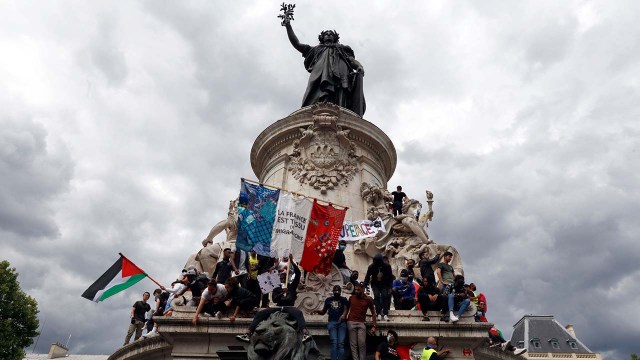
This Pew Research Center analysis focuses on attitudes toward diversity and conflict around the world. For this report, we conducted nationally representative surveys of 16,254 adults from March 12 to May 26, 2021, in 16 advanced economies. All surveys were conducted over the phone with adults in Canada, Belgium, France, Germany, Greece, Italy, the Netherlands, Spain, Sweden, the United Kingdom, Australia, Japan, New Zealand, Singapore, South Korea and Taiwan.
In the United States, we surveyed 2,596 U.S. adults from Feb. 1 to 7, 2021. Everyone who took part in the U.S. survey is a member of the Center’s American Trends Panel (ATP), an online survey panel that is recruited through national, random sampling of residential addresses. This way nearly all adults have a chance of selection. The survey is weighted to be representative of the U.S. adult population by gender, race, ethnicity, partisan affiliation, education and other categories.
This study was conducted in places where nationally representative telephone surveys are feasible. Due to the coronavirus outbreak, face-to-face interviewing is not currently possible in many parts of the world.
To account for the fact that some publics refer to the coronavirus differently, in South Korea, the survey asked about the “Corona19 outbreak.” In Japan, the survey asked about the “novel coronavirus outbreak.” In Greece, the survey asked about the “coronavirus pandemic.” In Australia, Canada, New Zealand and Taiwan, the survey asked about the “COVID-19 outbreak.” All other surveys used the term “coronavirus outbreak.” Here are the questions used for the report, along with responses. See our methodology database for more information about the survey methods outside the U.S. For respondents in the U.S., read more about the ATP’s methodology.
Wide majorities in most of the 17 advanced economies surveyed by Pew Research Center say having people of many different backgrounds improves their society. Outside of Japan and Greece, around six-in-ten or more hold this view, and in many places – including Singapore, New Zealand, the United States, Canada, the United Kingdom, Australia and Taiwan – at least eight-in-ten describe where they live as benefiting from people of different ethnic groups, religions and races.
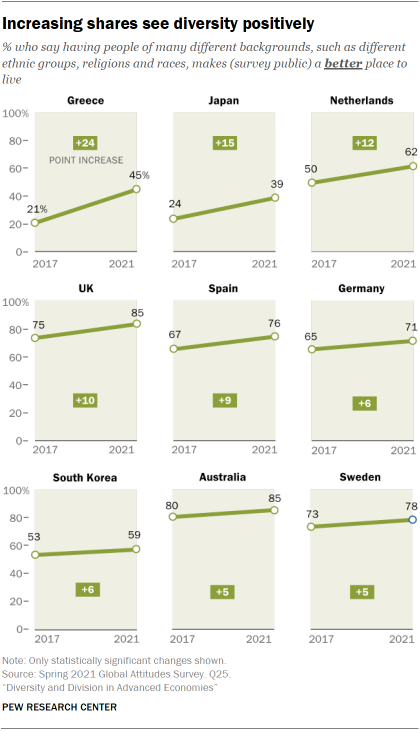
Even in Japan and Greece, the share who think diversity makes their country better has increased by double digits since the question was last asked four years ago, and significant increases have also taken place in most other nations where trends are available.
Alongside this growing openness to diversity, however, is a recognition that societies may not be living up to these ideals: In fact, most people say racial or ethnic discrimination is a problem in their society. Half or more in almost every place surveyed describe discrimination as at least a somewhat serious problem – including around three-quarters or more who have this view in Italy, France, Sweden, the U.S. and Germany. And, in eight surveyed publics, at least half describe their society as one with conflicts between people of different racial or ethnic groups. The U.S. is the country with the largest share of the public saying there is racial or ethnic conflict.
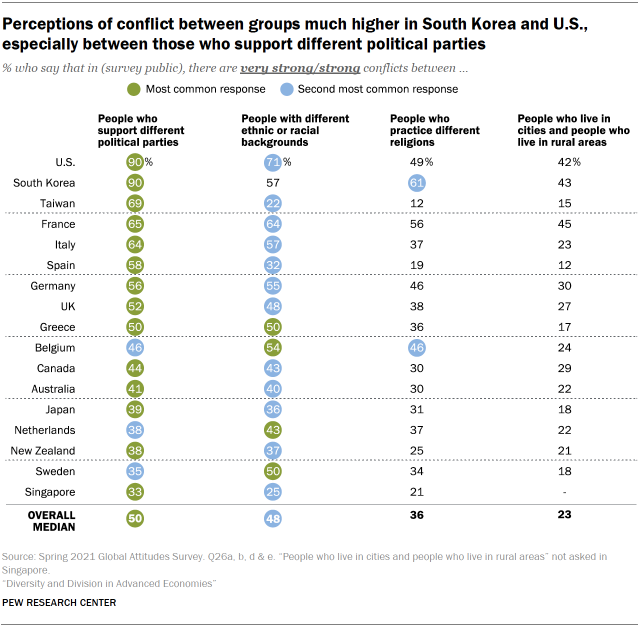
Notably, however, in most societies racial and ethnic divisions are not seen as the most salient cleavage. Rather, in the majority of places surveyed, more people identify conflicts between people who support different political parties than conflicts between people with different ethnic or racial backgrounds. Political divisions are also seen as greater than the other two dimensions tested: between those with different religions and between urban and rural residents. (For more on the actual composition of each public surveyed on each of these dimensions, see Appendix A.)
In the U.S. and South Korea, 90% say there are at least strong conflicts between those who support different parties – including around half or more in each country who say these conflicts are very strong. In Taiwan, France and Italy, around two-thirds say the political conflicts in their society are strong. Still, in around half of the surveyed publics, fewer than 50% say the same.
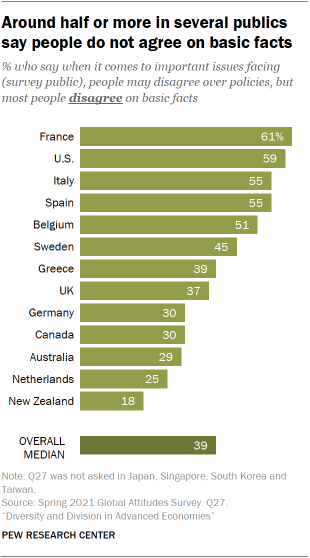
In some places, this acrimony has risen to the level that people think their fellow citizens no longer disagree simply over policies, but also over basic facts. In France, the U.S., Italy, Spain and Belgium, half or more think that most people in their country disagree on basic facts more than they agree. Across most societies surveyed, those who see conflict among partisans are more likely to say people disagree on the basic facts than those who do not see such conflicts.
Views on the topic are also closely related to views of the governing party or parties in nearly every society (for more on how governing party is defined, see Appendix B). In every place but the U.S. and Italy, those with unfavorable views of the governing coalition are more likely to say most people disagree on the basic facts than those with favorable views of the government.
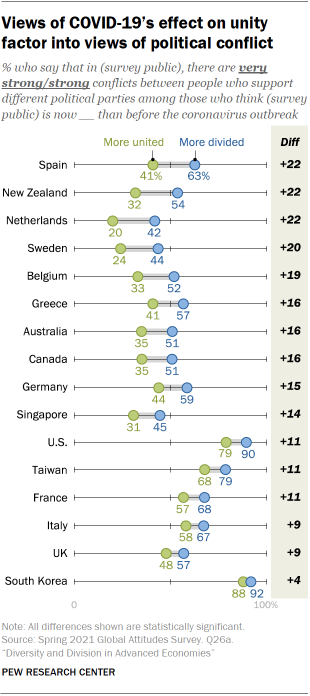
Although divisions between racial and ethnic groups as well as between partisans are palpable for many, other types of conflicts are less commonly perceived. For example, in no place surveyed does a majority think there are strong conflicts between people who live in cities and people who live in rural areas. Similarly, only a minority in most countries say there are divisions between people who practice different religions – though around half or more do sense such conflicts in South Korea, France and the U.S.
Beyond divisions between specific groups, there is also a widespread – and growing – sense that societies are more divided now than they were before the COVID-19 pandemic. A median of 61% across the 17 advanced economies say they are now more divided than before the outbreak, and in all but one of the 13 countries also polled in summer 2020, the sense that societies are more divided than united has risen significantly since last year. Those who describe their society as more divided than before the global health emergency are also significantly more likely to see conflicts between different groups in society and to say their fellow citizens disagree over basic facts.
Spotlight: Divided societies
In the U.S., France and South Korea, at least a majority say that having people of many different backgrounds makes their country a better place to live. Still, these three countries stand out for the degree to which people perceive various conflicts. In each of these places, the publics are among the most likely to describe their society as divided, and this is the case across each of the dimensions asked about: political, racial and ethnic, religious, and geographic.
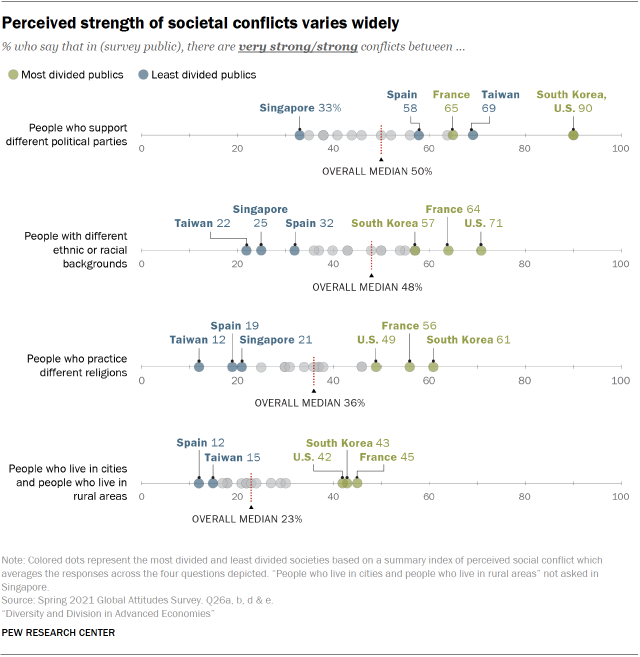
United States
When it comes to perceived political and ethnic conflicts, no public is more divided than Americans: 90% say there are conflicts between people who support different political parties and 71% say the same when it comes to ethnic and racial groups. (Results of a different question asking specifically about conflicts between Democrats and Republicans also found that 71% of Americans think conflicts between the party coalitions are very strong and another 20% say they are somewhat strong. The sense of conflicts between Democrats and Republicans also increased between 2012 and 2020.)
In terms of divisions between people who practice different religions and between urban and rural residents, again, Americans consistently rate as one of the three most divided publics of the 17 surveyed.
Some of these perceived divisions differ by racial and ethnic background. For example, more Black adults (82%) see conflict between people with different ethnic or racial backgrounds than White (69%) or Hispanic (70%) adults.
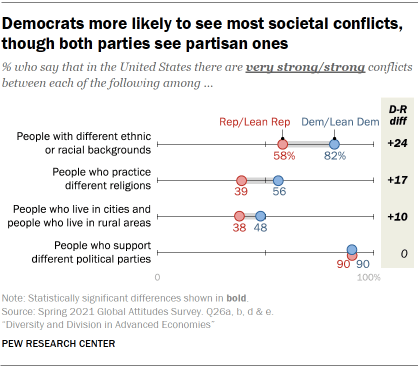
Another major axis of division in the U.S. is partisan identification. Democrats and independents who lean toward the Democratic Party are much more likely to see conflict between people of different racial and ethnic groups than are Republicans and independents who lean Republican. There are also partisan differences in opinion over whether people who practice different religions or those who live in urban and rural areas have conflicts.
Notably, however, both Democrats and Republicans share a widespread belief that there are conflicts between those who support different political parties. Democrats and Republicans are also equally likely to say Americans disagree over basic facts. For more, see “Americans see stronger societal conflicts than people in other advanced economies.”
France
On three of the four dimensions asked about, French adults are among the most likely to say there are conflicts – and the highest share in France perceives divisions between rural and urban residents. Partisanship plays some role in perceived divisions. Supporters of the Republicans, a right-of-center party, tend to see more conflicts than supporters of the Socialist Party or the ruling En Marche. For example, 76% who support the Republicans say there is conflict between people of different racial or ethnic groups, compared with 56% of Socialist Party supporters or 54% of En Marche supporters.1 French women are also more likely to see conflicts in many parts of their society than are men.
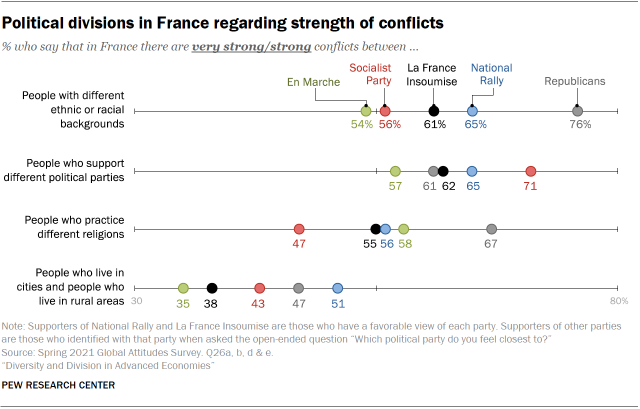
South Korea
More in South Korea than in any other public surveyed say there are conflicts between people who practice different religions (61%) in their society. They are also tied with the U.S. as the society where the highest share sees partisan divisions: 90% of South Koreans say this, including 50% who say such conflicts are very strong. And, on issues between ethnic and racial groups and between rural and urban residents, South Korea is consistently one of the top three most divided publics.
There is no single pattern to the divisions that South Koreans perceive in their society. Rather, depending on the conflict in question, different cleavages emerge. For example, when it comes to conflicts between rural and urban residents, those with lower incomes are more likely to identify conflicts than those with higher incomes. Younger South Koreans, for their part, are more likely to say there are racial or ethnic conflicts in their society than are older people, and those with higher education levels also agree relative to those with lower education levels.
Spotlight: Societies with fewer divisions
Singapore
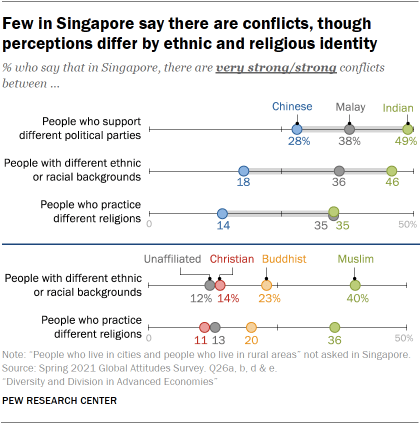
The small island nation of Singapore is one of the least divided societies surveyed. Although it is ethnically and racially diverse – and even boasts four official languages that correspond with the dominant ethnic groups – fewer Singaporeans (25%) report conflicts between people of different ethnic and racial backgrounds than nearly any other public surveyed. Singaporeans are also among the least divided religiously, with only 21% saying there are conflicts between people who practice different religions, despite being quite heterogeneous religiously. Notably, however, perceived divisions vary based on people’s self-reported ethnic and religious identity. For example, ethnic Indians and Malays are more likely to see political, ethnic and religious conflicts than ethnic Chinese. Similarly, Muslims are somewhat more likely to see conflicts both between those who practice different religions and those of different racial and ethnic groups than are self-reported Buddhists or Christians.
Singapore also stands out for seeing the fewest divisions between people who support different political parties (33%). The nation-state is largely governed by the People’s Action Party, which garnered around 61% of the vote and 89% of parliamentary seats in the most recent 2020 election, with the Worker’s Party securing the remainder. Singaporeans were not asked about conflicts between rural and urban residents because the nation-state is entirely urban.
Spain
Spaniards are the least divided among the 17 publics surveyed when it comes to geography, with only 12% of the public saying there are conflicts between rural and urban residents. Only 19% report conflicts among those who practice different religions, making it one of the two least religiously divided societies. And only around a third see conflicts between those with different racial and ethnic backgrounds, which ranks the country in the bottom three for this division as well. Still, when it comes to partisan differences, Spaniards see more conflicts. This country – which has active separatist movements, and has seen the collapse of the two-party system and the rise of populist parties – is one where a 58% majority see at least some conflict between those who support different political parties. Spaniards on the ideological left are somewhat more likely than those on the right to describe conflicts between partisans.
Taiwan
The share of adults in Taiwan who say there are conflicts between people who practice different religions (12%) is smaller than the share who say the same in any of the other places surveyed. They are also among the least likely to report conflicts between rural and urban residents (15%) and between those with different racial and ethnic backgrounds (22%). Still, adults in Taiwan do see major divisions between those who support different political parties: 69% say there are conflicts, which ranks the island among the top three most politically divided locations. Supporters of the governing Democratic Progressive Party (DPP) and nonsupporters are equally likely to see such political disagreements.
These are among the findings of a new Pew Research Center survey, conducted from Feb. 1 to May 26, 2021, among 18,850 adults in 17 advanced economies. Other key findings include:
- People on the ideological left are often more likely to say diversity improves their societies, as well as to describe discrimination as a problem. But when it comes to identifying conflicts between different racial and ethnic groups, the relationship varies. In the U.S. and Greece, those on the left are more likely to describe these racial tensions than those on the right, whereas in Sweden, Italy and Germany, the opposite is true.
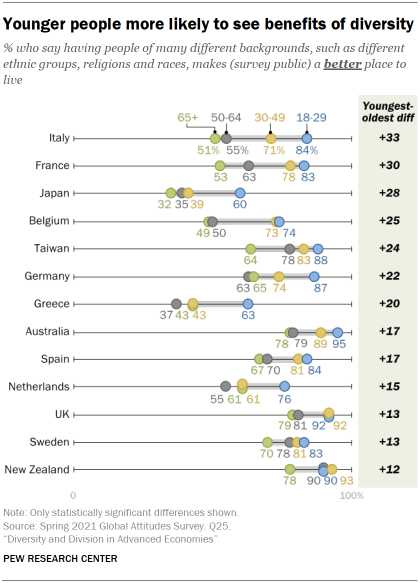
- Younger respondents tend to say people of different backgrounds make their society a better place to live – but also tend to see more conflicts and discrimination in their society than older people. For example, in Greece, around six-in-ten of those under age 30 say having people of many different ethnic groups, religions and races improves their society, compared with only around four-in-ten of those ages 65 and older who say the same. Yet those under 30 are also around twice as likely – or more – as those ages 65 and older to report conflicts between people who support different parties, between different ethnic groups, and between different religious groups.
- In some publics, people who think the economy is doing well tend to see fewer conflicts between groups in their society and see more benefits stemming from diverse people living around them.
Diverse society seen positively in most advanced economies
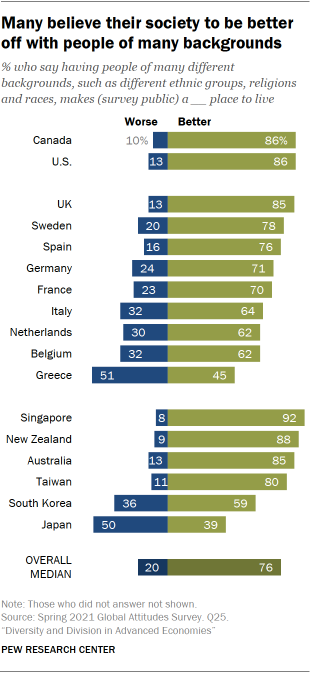
Across most of the 17 advanced economies surveyed, majorities – and in many cases, large majorities – say that having people of many ethnic groups, religions and races makes their society a better place to live. This opinion is most strongly held in Singapore, where 92% say that having people of different ethnic groups, religions and races makes Singapore a better place to live. Eight-in-ten or more in New Zealand, the U.S., Canada, the UK, Australia and Taiwan also say having people of many different backgrounds makes for a better place to live.
But this opinion is not universally held. About half of Greek and Japanese adults say that having a diverse society makes their country a worse place to live. Still, this represents significant declines from 2017, when majorities in Greece (62%) and Japan (57%) said diversity makes their country a worse place to live.
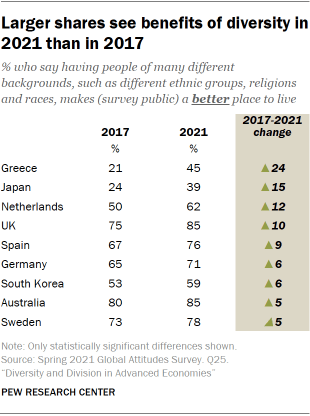
In fact, attitudes have generally become more open to diversity since the question was last asked in 2017. The share who say having people of many different backgrounds makes their society a better place to live has increased significantly in nine of 11 countries where the question was posed in both 2017 and 2021. Views have changed most dramatically in Greece, where 45% now say having people of many different backgrounds makes their society better compared with just 21% who held that view in 2017, an increase of 24 percentage points.
While majorities in nearly every survey public agree that diversity in society is a positive, younger people and those with more education are significantly more likely than older people and those with less education to hold this opinion.
For example, 84% of Italians ages 18 to 29 say having people of many different backgrounds makes Italy a better place to live, while about half (51%) of Italians ages 65 and older agree. Italy also has the largest attitudinal gap between those with a postsecondary education or more and those with less than a postsecondary education: 89% of more educated Italians view diversity positively, compared with 58% of educated Italians with less education, a gap of 31 points.
Wealthier people express more positive views of diversity than those with lower incomes in some of the places surveyed. For instance, nine-in-ten Britons with higher incomes say having people of many different ethnic groups, races and religions makes the UK a better place to live; eight-in-ten Britons with lower incomes say the same. Income gaps also appear in Italy, Australia, France, Belgium, Sweden, Canada, Singapore and the U.S.
And in 12 of 17 advanced economies, those who say the current economic situation is good are significantly more likely to say diversity makes their society better than those who say the economic situation is bad.
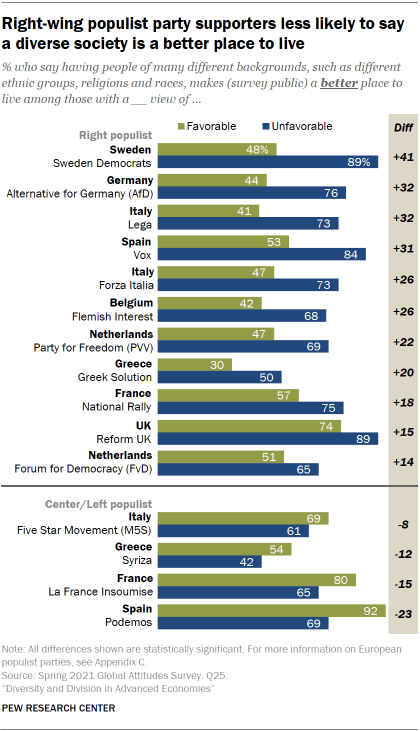
Large divides on the question appear between supporters and nonsupporters of right-wing populist parties in Europe, many of which advocate for strict anti-immigration policies and openly oppose multiculturalism (for more on how populist parties are defined, see Appendix C). The divide is largest between those with favorable and unfavorable views of Sweden Democrats (48% vs. 89%, respectively).
On the other hand, supporters of center and left-wing populist parties in Italy, Greece, France and Spain are more likely to say diversity makes their country a better place to live.
Discrimination seen as a serious problem in most advanced economies
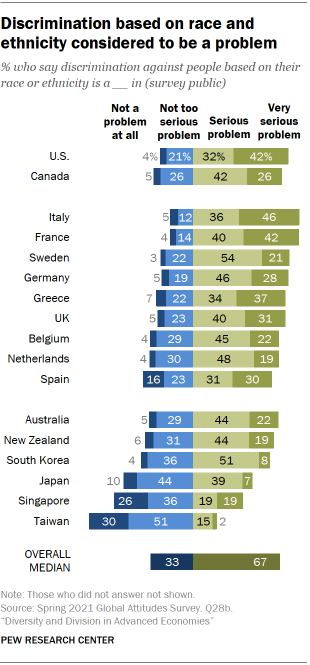
When it comes to racial and ethnic discrimination, a median of 67% say it is a serious or very serious problem in their own society, though views vary widely.
Americans and Canadians generally agree that racial and ethnic discrimination is at least a serious problem in their respective countries. Around three-quarters of Americans think so, as do around two-thirds of Canadians.
Across Europe, a median of around seven-in-ten say discrimination against people based on their race or ethnicity is a serious or very serious problem, while only about a quarter think it is not too serious of a problem or not a problem at all. Italy reports the highest percentage of adults who say racial and ethnic discrimination is a very serious problem (46%).
In the Asia-Pacific region, views on the topic vary more widely than in Europe and North America. At least six-in-ten Australians and New Zealanders say discrimination against people based on their race and ethnicity is a serious or very serious problem in their country. Taiwan, Singapore and Japan are the only places surveyed where majorities say discrimination is either not too serious or not a problem at all.
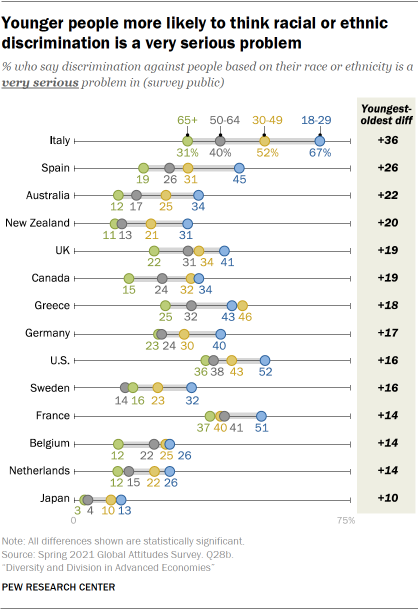
In 14 of the 17 advanced economies surveyed, younger people are significantly more likely than older people to say racial or ethnic discrimination is a very serious problem. This is is especially true in Italy, where two-thirds of Italians ages 18 to 29 say racial or ethnic discrimination is a very serious problem, while only about one-third of Italians ages 65 and older say the same.
Age gaps of 20 percentage points or more also appear in Spain, Australia and New Zealand. Even in Japan, where only 7% overall say racial or ethnic discrimination is a very serious problem, adults under 30 are 10 points more likely than those 65 and older to hold this view (13% and 3%, respectively).
While there are few differences in responses by education or income, women are more likely than men to say racial or ethnic discrimination is a serious or very serious problem in 13 of 17 publics surveyed.
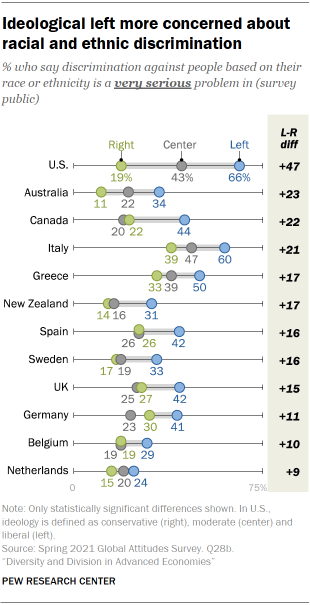
In keeping with previous findings that ideological divisions in the U.S. are wider than in other countries, the U.S. is by far the most ideologically divided on the question of racial and ethnic discrimination. About two-thirds of Americans on the left say racial and ethnic discrimination in the U.S. is a very serious problem; only 19% of Americans on the right hold that view.
Still, there are significant left-right divides in many other countries on the seriousness of racial and ethnic discrimination. Australians, Canadians and Italians on the left are more than 20 points more likely than those on the right to say discrimination based on race or ethnicity is a very serious problem in their country.
Perceived social conflict
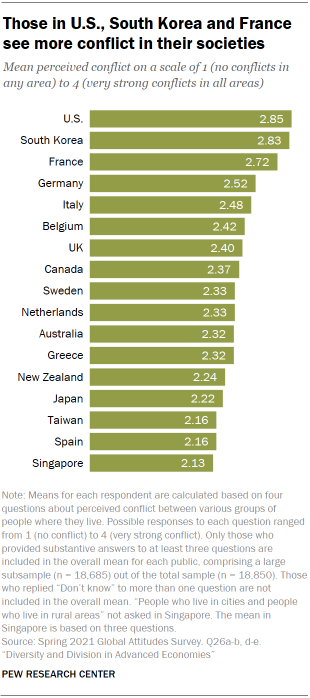
To understand how people view divisions in their societies, we asked about the strength of the conflict that people see between various groups, including: 1) those who support different political parties, 2) those with different ethnic or racial backgrounds, 3) those who practice different religions and 4) those who live in cities compared with those who live in rural areas. (For more on each society’s composition across these four dimensions, see Appendix A.)
We created a summary index of perceived social conflict by averaging responses across the four questions. Higher values indicate that, on average, people see more friction between groups in their society.
Perceived conflict is highest in the U.S., South Korea and France. Notably, Koreans are much more likely than others in the Asia-Pacific region to view conflict among social groups. Four of the five publics with the lowest conflict scores are in this region: Singapore, Taiwan, Japan and New Zealand. In contrast, conflict scores tend to be relatively higher in North America and Europe. Here, Spain is the exception, with a generally low average. Though the overall magnitude varies across the 17 publics surveyed, most show the same pattern when it comes to which groups are more or less likely to be divided. Overall, people see the strongest conflicts among those who support different political parties and those with different ethnic or racial backgrounds. In comparison, people tend to see less conflict among those who practice different religions. And relatively few see strong tensions between people who live in cities and people who live in rural areas.
Perceived conflict between supporters of different political parties
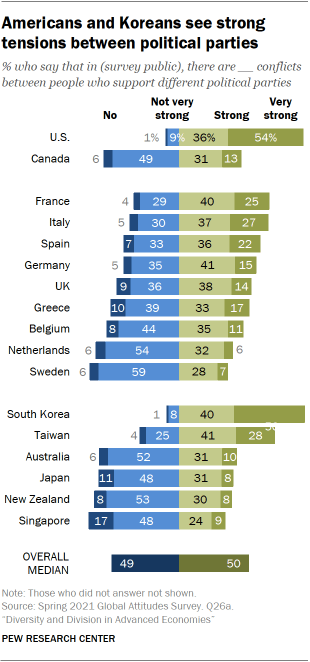
A median of 50% across the 17 publics surveyed say there are strong conflicts between people who support different political parties. This sentiment is particularly high in the U.S. and South Korea, where nine-in-ten see tensions between different party backers. At least half in both countries say these conflicts are very strong.
Compared with their southern neighbors, Canadians see their country as much less divided across party lines. Only 44% think there are strong partisan conflicts. (The survey was conducted before Canadian Prime Minister Justin Trudeau called a snap election in August 2021.)
In Europe, majorities in France, Italy, Spain and Germany say there are strong conflicts between supporters of different political parties. A quarter or more in France and Italy see these tensions as very strong. Sweden and the Netherlands are among the least politically divided countries in this region, with 35% and 38% seeing strong conflicts, respectively. While people in South Korea are the most likely in the Asia-Pacific region to see strong conflicts between different party backers, nearly seven-in-ten in Taiwan hold the same view. Relatively few in the rest of the region say there are strong partisan conflicts in their society. Singaporeans feel particularly united when it comes to politics; 17% say there are no conflicts at all.
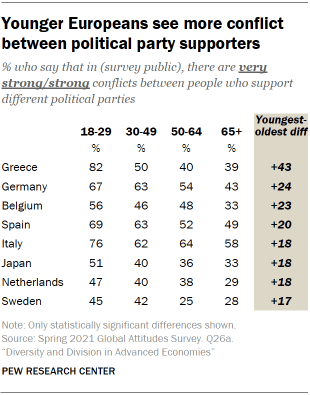
In many of the European countries surveyed, younger adults are more likely than those ages 65 and older to say there are strong conflicts between supporters of different political parties. Younger and older Greeks are especially divided. Only 39% of Greeks ages 65 and older think there are strong partisan tensions in their country, compared with 82% of Greeks ages 18 to 29.
Similar, though smaller, differences can also be seen in Germany, Belgium, Spain, Italy, the Netherlands and Sweden. Outside of Europe, a third of older adults in Japan see their country as politically divided, compared with roughly half of those under 30.
Notably, there are very few differences by ideology or support for the governing party. In the U.S., for example, Republicans and Republican-leaning independents are just as likely as Democrats and Democratic-leaning independents to think there are strong partisan tensions in the U.S. (both 90%).
There is a relatively strong correlation between perceptions of partisan conflict among the general public and the views of experts (r=+0.72). In publics where larger shares of survey respondents say there is tension between different party backers, experts generally report greater political polarization (according to the V-Dem political polarization measure, which quantifies the extent to which trained coders view each public as polarized into antagonistic political groups).
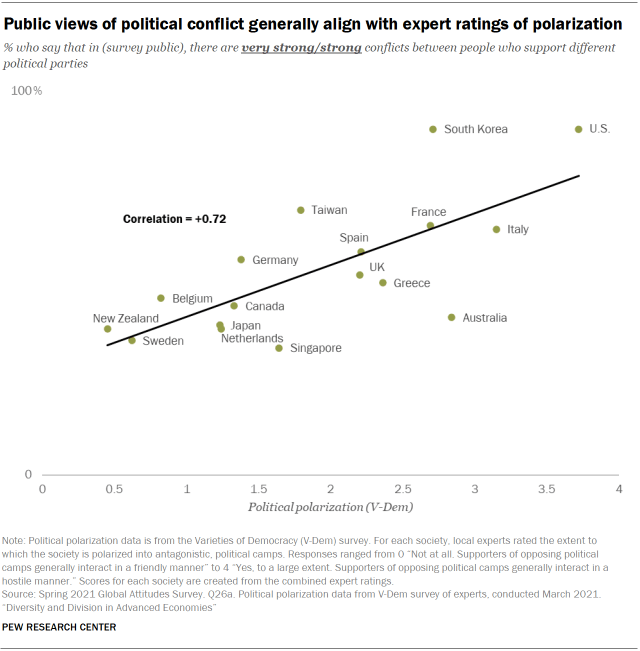
Additionally, the share of people across the 17 publics surveyed who say there are very strong conflicts between supporters of different political parties is moderately correlated (r=+0.59) with the share of seats received by the second-largest party in an election. For example, in the 2020 election in Taiwan, the Democratic Progressive Party (DPP) received 54% of the seats in Taiwan’s legislature while the Kuomintang (KMT) – the second-largest party – received 34%, making for a relatively divided chamber. Roughly three-in-ten in Taiwan say there are very strong partisan conflicts in their society. Toward the other end of the spectrum, one can look at Japan, where the ruling Liberal Democratic Party (LDP) won 59% of seats in the House of Representatives in the 2017 election, while the second-largest party – the Constitutional Democratic Party (CDP) –received just 11%. In Japan, a much smaller share of the public describes very strong tensions between different party supporters (8%).
Perceived conflict between people with different ethnic or racial backgrounds
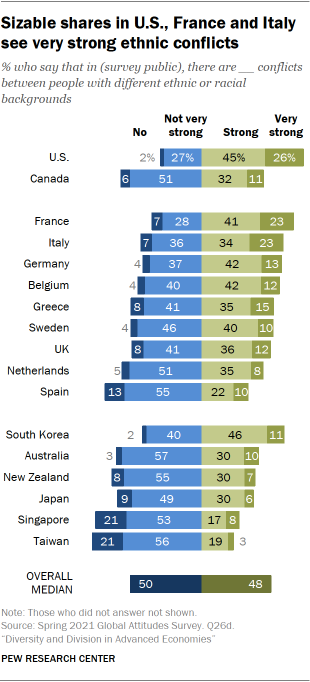
Many people across the 17 advanced economies surveyed see strong conflicts between people with different ethnic or racial backgrounds (a median of 48%). People in the U.S. (71%), France (64%) and Italy (57%) are particularly likely to view these tensions as strong, with around a quarter in each country who say they are very strong. While majorities in South Korea and Germany also say there are strong conflicts in their society, only around one-in-ten rate them as very strong.
In Sweden, Belgium and the Netherlands, people are more likely to say there are strong conflicts between people from different ethnic or racial backgrounds than between people who support different political parties. In Sweden, for example, while only 35% see their country as politically divided, 50% see tensions based on race or ethnicity.
In about half of the publics surveyed, women are more likely than men to say that there is friction between people from different ethnic backgrounds. For example, 49% of German men compared with 61% of German women hold this view. Similar gender differences are seen in Belgium, France, Greece, Italy, the Netherlands, New Zealand and Taiwan.
Overall, there are few ideological differences. In Germany, Sweden and Italy, those on the right of the ideological spectrum are more likely than those on the left to see strong conflicts between people from different racial and ethnic backgrounds. This pattern is reversed in Greece and the U.S., with those on the left more likely to say that there are racial or ethnic tensions in their countries.
Consistent with the ideological differences in the U.S., Democrats (82%) are much more likely than Republicans (58%) to say there are strong conflicts based on race and ethnicity in their country. And Black Americans (82%) see more conflict between people of different racial and ethnic backgrounds than White (69%) and Hispanic Americans (70%).
Perceived conflict between people who practice different religions
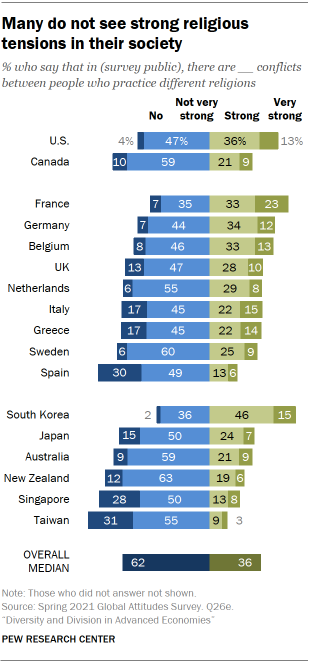
Overall, fewer people see strong religious conflicts, compared with conflicts based on politics or race. A median of 36% across the 17 publics surveyed say there are strong conflicts between people who practice different religions in their society.
South Korea and France are the only places surveyed where more than half of people say there are strong divisions based on religious beliefs. And in France, almost a quarter say these conflicts are very strong.
Roughly half of Americans say there are strong conflicts between people who practice different religions in their country, including 13% who say there are very strong conflicts.
In Europe, people in Spain are by far the least likely to say there are strong religious tensions. Only 19% of Spaniards hold this view. More say that there are no conflicts between different religious groups at all in their country (30%).
Again, South Korea is an outlier in the Asia-Pacific region. Koreans are nearly twice as likely as those in Japan, which has the second-highest share in the region, to say there are religious tensions in their country. In contrast, roughly three-in-ten in Singapore and Taiwan say there are no religious conflicts at all.
Adults under 30 are more likely than those ages 65 and older to see strong religious divisions in Greece, Belgium, Japan, Italy, the U.S., Spain and Taiwan. And again, Greeks are the most polarized by age, with 60% of younger adults and 24% of older adults saying there are strong conflicts based on religion in their country.
Different kinds of religious conflict
The survey included two questions measuring perceived religious conflict: 1) conflict between people who practice different religions and 2) conflict between people who are religious and people who are not religious. The separate questions were included to determine if people viewed tensions between, for example, Christians and Muslims, as stronger or weaker than conflicts between people who identify with a religion and those who do not.
The differences between these two questions were negligible. In most countries, similar shares say there are strong conflicts between people who practice different religions and between those who are religious and those who are not. Across the 17 publics surveyed, the correlation between the questions was extremely high (r=+0.97). Considering the similarities between the questions, we focus on just one for our analysis: conflict between people who practice different religions.
However, perceptions of religious conflict differ somewhat by ideology in several countries. For example, conservatives in the U.S. are more likely to see strong conflicts between people who are religious and those who are not (50%) than between different religious groups (39%). Liberals respond nearly the same to both questions. And in Sweden, people on the left are less likely to see conflicts between people who are religious and those who are not (12%) than between different religious groups (26%).
In Germany, Canada and Italy, there are ideological divides in the extent to which people see conflicts between those who are religious and those who are not, with people on the right more likely to see conflicts than those on the left. But people on the left and right in these countries agree on the extent to which there are conflicts between different religious groups.
Perceived conflict between people who live in cities and people who live in rural areas
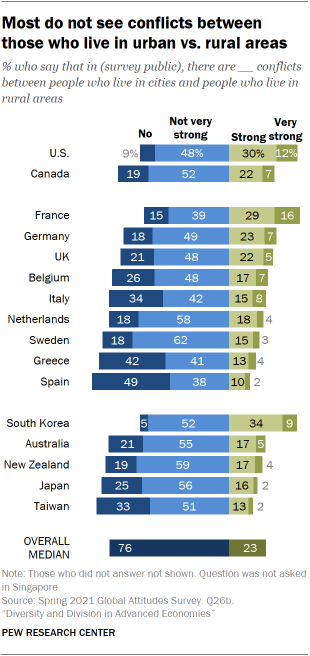
A median of just 23% say there are strong or very strong conflicts between people who live in cities and people who live in rural areas. Half say there are not very strong conflicts and 20% say there are no conflicts at all between these groups. (Medians are based on 16 publics. This question was not asked in Singapore, a geographically small island nation with an entirely urban population.)
Again, France, South Korea and the U.S. stand out as particularly divided. Roughly 45% in each country say there are strong or very strong tensions based on geography. Elsewhere, no more than three-in-ten share this sentiment.
Spaniards are the most likely to say that there are no conflicts at all between those who live in cities and those who live in rural areas (49%). In Europe, at least a quarter in Belgium, Italy and Greece say the same.
Similarly, many in the Asia-Pacific region – with the exception of South Korea – say there are not very strong or no conflicts based on what type of area people live in. Roughly one-in-five or more in New Zealand, Australia, Japan and Taiwan say there are no divisions at all between city-dwellers and people who live in rural areas.
People across the ideological spectrum tend to agree that there are limited conflicts based on the type of area people live in. In the U.S., however, people on the left (53%) are more likely than those on the right (38%) to say that there are strong or very strong conflicts between people who live in urban areas and people who live in rural areas.
In six European countries – Belgium, the UK, Germany, France, the Netherlands and Greece – those with a secondary education or below are more likely than people with postsecondary education to say that there is friction based on where people live in their country. In the U.S., the opposite is true; people with more education are more likely than those with less to say there are strong conflicts between people in urban and rural areas.
Majorities of some publics say most people agree on basic facts
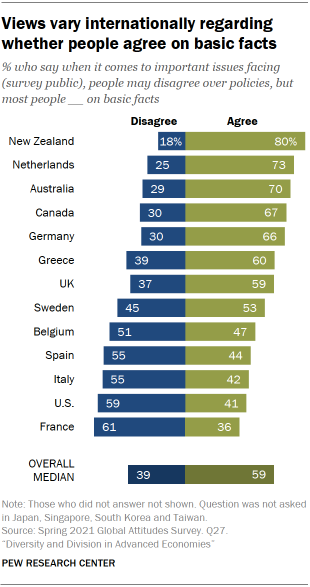
A median of 39% believe there are fundamental disagreements over basic facts in their society. In France and the U.S., about six-in-ten say most people in their country disagree over basic facts, while half or more also hold this view in Italy, Spain and Belgium. In contrast, roughly two-thirds or more in New Zealand, the Netherlands, Australia, Canada and Germany think most people agree on basic facts, even if they disagree about policies.
This high sense of disagreement over facts may be due, at least in part, to struggles to combat pandemic-related conspiracy theories. In most places surveyed, those who believe COVID-19 has made their society more divided are much more likely to say people disagree over basic facts than those who say COVID-19 has made their society more united.
Perception of political conflicts is strongly tied to whether adults think their fellow citizens agree or disagree on basic facts. In every public surveyed, those who say there are very strong or strong conflicts between people who support different political parties are more likely to think people disagree on basic facts. This divide is largest in Sweden: 62% of Swedes who say there are political conflicts think most people disagree about basic facts, compared with only 37% of Swedes who say there are not very strong or no conflicts between people who support different political parties.2
Views on the topic are closely related to views of the governing party or parties in each place surveyed. Outside of the U.S. and Italy, in every other public those with unfavorable views of the governing coalition are more likely to say most people disagree about basic facts than those with favorable views of the government.




